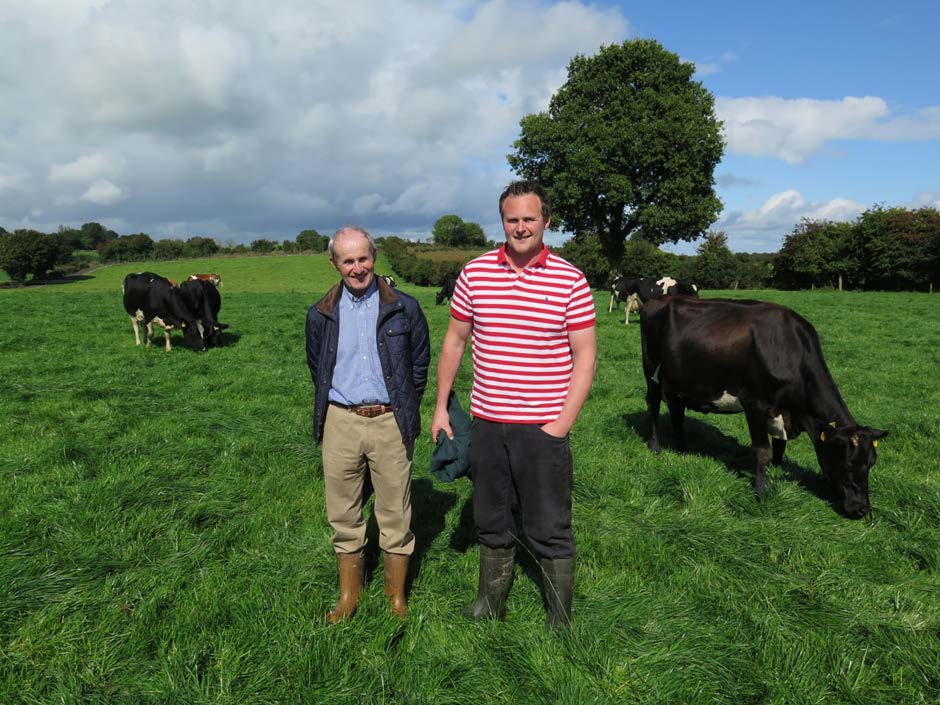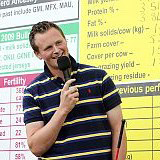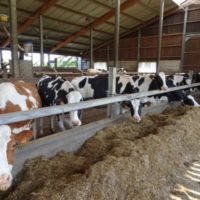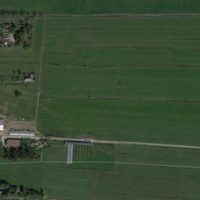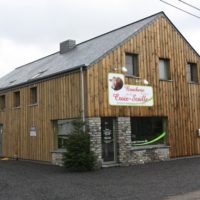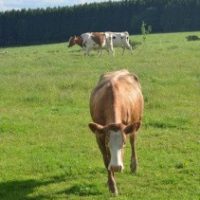Grassland innovation: setting up 2 milking units for grazing
Farm: “Eddie O’Donnell”
Location: Golden, Co. Tipperary, Ireland
Case study
 Grassland innovation: setting up 2 milking units for grazing (.pdf)
Grassland innovation: setting up 2 milking units for grazing (.pdf)
Description
Background
The Mission statement of our farm business is as follows: “To run a highly efficient, profitable and sustainable dairy business while also enjoying a good family life”.
I am farming with my wife Fiona and parents Denis and Nora, near Golden, Co. Tipperary. Fiona and I have three children – Muireann (4), Meabh (2) and Eddie (7 months). We milked 318 cows in 2017, supplying milk to Dairygold Co-op and Kerry Group, and we currently farm a total of 160 hectares. We are operating from 2 milking parlours since 2006.
116 ha of our land holding relates to our two milking platforms split as follows:
- 74 adjusted ha: Home Farm (43 owned, 31 leased)
- 42 adjusted ha: Out Farm (all leased and located 6 miles from home farm).
The remaining 44 ha are divided into two blocks as follows:
- 20 adjusted ha: ( All owned and located 12 miles from Home Farm)
- 24 adjusted ha: (4 owned, 20 Leased and located 2 miles from Home Farm)
These farms are used predominantly for grazing the replacements and for silage production.
We have two employees, Jeremy Furlong and Philip Roche. Philip works on the home farm with me, while Jeremy runs the out farm milking platform.
Having grown up on a dairy and beef farm enterprise, I was passionate about farming from an early age, and I never considered any other career choice apart from farming. After finishing secondary school in 2000, I went to Rockwell Agricultural College for one year to complete my Certificate in Agriculture. I subsequently achieved my Certificate in Farming in Pallaskenry Agricultural College. As part of my studies, I completed my practical placement through the Farm Relief Services. From 2002 to 2005, I managed a 90 cow farm located six miles from home. Having gained good experience from my time away, I returned home to set up a partnership with my parents in late 2005.
I travelled to New Zealand in August 2005 with a number of experienced progressive farmers and researchers from Moorepark. This trip proved to be very beneficial in my development and opened my mind to the vast array of opportunities that exist. Also as a result of this trip, my parents and I began to complete our five year farm plans, which we continue to review and revise annually. This planning has been the catalyst of our significant farm growth to date (50 ha and 70 milking cows in 2005 vs 160 ha and 318 milking cows in 2017).
Detailed description
Grassland
Grassland management for us is based around a number of cornerstones; soil fertility, re-seeding, infrastructure, grass measurement and management.
Soil fertility
It is an essential part of grassland farming to have the correct pH and have the soil index for P and K at index 3 or 4, so for this reason we soil sample the farm every two years and this helps us keep on top of what changes are occurring. We have noticed K levels dropping off in paddocks that are removed for surplus bales so we try and avoid taking bales or silage off lower K index paddocks. We put a fertiliser plan in place annually, and stick to it by spreading fertiliser when it has to be spread and spreading the right amount of it. We have colour coded maps up in the dairy which indicate the soil index of the paddocks so we can target more parlour washings and slurry to the lower ones, and this map also helps us avoid taking bales from them by making sure the cows hit those paddocks at the correct pre grazing yield thus leaving at the right post-grazing height.
Reseeding
We have re-seeded all the milking platform and one of the young stock farms over the past seven years. We select the paddocks for re-seeding from the cumulative growth chart on PastureBase Ireland at the end of the year, and we aim to do our re-seeding in spring time as we find this the quickest turnaround time with the least risk. We are part of the grass variety monoculture trial in Moorepark and have set all monocultures on the milking platform over the past five years and three way mixes on the out farm. We have many different varieties across the farm.
Infrastructure
There is no point in growing lots of grass if it can’t be consumed by the cow. We have put in extra roadways and extra water tanks on the farms over the last five years. As cow numbers have increased demand for water obviously increased, so we had to install bigger piping from the yard and extra tanks in the paddocks. The infrastructure plays a big part in grass utilisation especially in spring by helping us get out at almost every milking from when cows start to calve. We also use reels to create single file spurs off these roadways at the shoulders of the year to get the cows in and out of paddocks if conditions are wet.
Grass measurement
We began grass measuring on the farm in 2004. We walk the farm weekly during the grazing season and twice weekly during the main season when growth is high. There are several reasons for grass measuring. We aim to use grass well, we need to know how much we have, it gives us higher milk solids, it helps to lower the cost of milk production, and ease of management in a simple system. As we know what the farm is growing we can establish the correct stocking rate for our farm. It also identifies underperforming paddocks and we can predict when a surplus or a deficit is arising which helps us to avoid wasting grass by keeping the quality of grass in front of the cow consistent. We will complete up to 50 walks on PastureBase Ireland this year. Everyone on the farm can complete a grass cover, the most important part of the process is the decisions that are made from producing the grass wedge or average farm cover figure on the shoulders.
Management
The management is all about timing on our farm, we have set cover targets for different stages of the year, e.g. Closing farm cover of 700 kg DM/ha on December 1st. We have targets for percentage of the farm grazed in spring and autumn, we want to start the second rotation on April 1st in order to do that we require 40% of the farm grazed March 1st to have enough paddocks growing back for April 1st. A week can make a big difference on a grass based farm from running into a surplus or into deficit quickly so when you have information one needs to react by pulling out surplus or putting in supplement depending on the situation. We had over 10 grazings per paddock and one silage cut in 2017, and the only way our farm can do this is by having a number of 16-18 day rotations during the main season.
Results
Our farm jigsaw is simply made up of three critical pieces – grass, people and cows. There is nothing fancy to what we do, but what we do we try to do right, and to make sure that we review and set achievable targets for ourselves. A consistent approach to grassland management, as well as having the right team of people working with us, has always been and will continue to be a pivotal part of our business strategy. The importance of choosing the correct type of cow for our farming enterprise cannot be underestimated. We feel that we are not doing many things differently to most farmers. I’d like to thank our Teagasc Advisor Sandra Hayes who is always there if we have a question or query on anything. Discussion groups play a big part on our farm and we’re involved in four of them, and we try to learn something through all of them. We are very lucky in Ireland to have a world class facility in Moorepark demonstrating and researching best practice.
In summary:
- Grassland production on the farm was 18.6 t DM/ha with 10 grazings and one silage cut per paddock in 2017
- 50 grass walks were completed on the farm last year, this is crucial to our grassland management
- Soil fertility is at index 4 for P and index 3 for K, soil pH is 5.9
- During the mid-season we try to match grass supply with grass demand
- We will continue to reduce the variation in DM production between paddocks, with better soil fertility and re-seeding the lower producing paddocks.
- We will not increase the number of grazings from the farm by reducing pre-grazing yields any further than where we are now.
Overall the last five years this farm has produced, on average, 17.6 t DM/ha, so the farm has huge capacity to grow. Our job is really to manage what is growing and to make sure that we utilise it as grazed grass. So in the past number of years we have focussed more and more on getting more grazings from the paddocks, increasing paddock grazings will reduce the level of silage harvested on the milking block, and we really don’t cut any silage off the grazing platform. Given our stocking rate it makes it difficult to cut main silage cuts, so the strategy is to take surpluses off as round bale silage.
Spring grazing
In general, we start grazing from early February (first week), ground conditions on this farm are usually not limiting so we can send the cows to grass as they calve. In recent years we have been trying to lift the opening farm cover to >900 kg DM/ha at turnout, the compactness of calving and higher stocking rate is pushing us in that direction. Given that we have two farms working, we generally try to have a higher cover here in the Golden mfarm, ultimately because we calve all the cows at home, the Golden farm takes more grazing in February than the Dundrum farm. The spring grazing target is to have 40% grazed by March 1st, this has been difficult this year with grazing conditions (snow and rainfall).
We are now getting to the magic figure of 10 grazings on the farm with one silage cut. As I said previously this would not be possible without having shorter rotations in the mid-season, but also our focus to finish the first rotation early in April. We are usually well into the third rotation by May 1st in a normal year. The number of grazings per paddock is a great way of profiling the performance of the paddocks from a grazing perpective.
Mid-season
The daily grass demand on the farm mid-season is approximately 68 kg DM/ ha (4 cows/ha . 17 kg daily herbage allowance), so we aim to keep grass supply as consistent as possible, the farm is walked regularly which keeps us on our guard to monitor grass supply. We have no problem taking rotation length down to 16 days mid-season and this has helped us increase the number of grazings per paddock. We have a target of 160 kg DM/cow during this period, our mid-season growth rate helps us to achieve this. We don’t top paddocks on the farm, we try to let the cows graze at the appropriate pre-grazing yields and this helps to keep topping out of the equation. If a paddock is badly grazed we will earmark it for round bale silage on the next round. Our grazing regime is to graze to on average to 4 cm during the season.
Autumn
Generally in autumn, we build to pre-grazing covers of 2000 kg DM/ha, we find it hard to go beyond that with the grazing platform stocking rate, so 350-400 kg DM/cow is our target in mid-September. We try to start closing in early October and will aim for 70% closed by the end of the first week of November. We have to have grass on the farm at turnout and will be aiming for higher spring turnout covers given this spring.
Adoption criteria
Grassland management has become a key driver to the business over the past few years since we were exposed to it through our local Teagasc discussion group. We have been aggressively reseeding as much land as we can each year be that on silage or grazing blocks. Soil samples are taken on milking platforms every year and all other land every second year. We measure more than 40 times per year and try to put together as much data as we can to help us grow and utilize more grass.
Future prospects
We have worked very hard over the past number of years on increasing grass DM production on individual paddocks. Focussing on our soil fertility to improve this has been essential; we now have a reasonably good soil fertility profile across the farm, soil pH 5.9 (range 6.2 – 5.6), (we have spread 700 t of lime since August 2017), soil K – 131 mg/l (range 65 – 206 mg/l), soil P – 9.7 mg/l (range 4.2 – 26.1 mg/l). We don’t cut bales from paddocks with low K. Each year we will look at the individual paddock performance and see what paddocks are doing well, especially from a grazing viewpoint. The farm is targeting more grazings, but we don’t want to drop pre-grazing yields any further than where they are, the year average is 1,700 kg DM/ha, but mid season we are going into covers of 1200-1400 kg DM/ha. We want varieties that have good graze out, so far this focus hasn’t compromised DM production. Tetraploids have worked well here and we have no problem grazing 100% tetraploid on the farm. Figure 3 (and Table 1) shows the DM production of individual paddocks for 2017. We will continue to try and minimise the variation in DM production between paddocks and will continue to re-seed the lower performing paddocks. Measuring grass is the basis for this decision making; having this data built up over years is now beginning to position us better as a grassland farm.
Additional information
| Farming system | conventional farming |
|---|---|
| Domains of innovation | farm system, forage mixture, grazing management system |
| Main types of animal | dairy cattle |
| Country | Ireland |
| Product type | Case study |
| Language | English |

